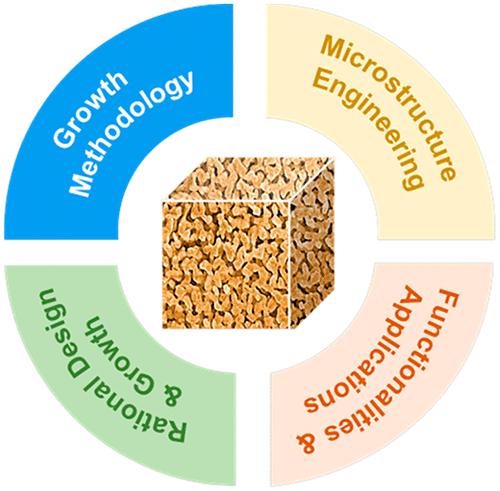当前位置:
X-MOL 学术
›
Acc. Chem. Res.
›
论文详情
Our official English website, www.x-mol.net, welcomes your
feedback! (Note: you will need to create a separate account there.)
Porous Single Crystals at the Macroscale: From Growth to Application
Accounts of Chemical Research ( IF 16.4 ) Pub Date : 2023-01-27 , DOI: 10.1021/acs.accounts.2c00777 Wenting Li 1 , Kui Xie 1, 2
Accounts of Chemical Research ( IF 16.4 ) Pub Date : 2023-01-27 , DOI: 10.1021/acs.accounts.2c00777 Wenting Li 1 , Kui Xie 1, 2
Affiliation

|
Porous materials have wide applications in the fields of catalysis, separation, and energy conversion and storage. Porous materials contain pores that are specifically designed to achieve expectant performance. The solid phases in porous materials are normally completely continuous to form the basic porous frame while the pores are fluid phase within the solid phase. Single crystals are macroscopic materials in three spatial dimensions with the constituent atoms, ions, molecules, or molecular assemblies arranged in an orderly repeating pattern with the ordered structures. The growth of single crystals is indeed a process to arrange these constituents in three dimensions into a repeating pattern within the materials. Today the applications of single crystals are exponentially growing in wide fields, and single crystals are therefore unacknowledged as the pillars of our modern technology. Introducing porosity into single crystals would be expected to create a new kind of porous material in which the basic porous frames are single-crystalline and free of grain boundaries. The structural symmetry is completely maintained within the basic porous frames which are a continuous solid phase, but it is completely lost inside the pores. The porous architecture is free of grain boundaries, and the fully interconnected skeletons are in single-crystalline states within the basic porous frames. Single crystals with porosities can therefore be considered to be a new kind of porous material, but they are single-crystal-like because the structural symmetry is maintained only in the skeletons and completely lost within the pores. We therefore call them porous single crystals or consider them in porous single-crystalline states to stand out with their structural features. Porous single crystals at the macroscale combine the advantages of porous materials and single crystals to incorporate both porosity and structural coherence in a porous architecture, leading to invaluable opportunities to alter the material’s properties by controlling the unique structural features to enhance its performance. However, the growth of single crystals in three dimensions reduces the formation of porosities, leading to a fundamental challenge for introducing porosity into single crystals in a traditional process of crystal growth. In this Account, we report the rational design, growth methodology, and microstructural engineering of porous single crystals in a solid–solid transformation. We rationally design a high-density mother phase in a single-crystalline state and transform it into a low-density new phase in a single-crystalline state to introduce porosities into single crystals even incorporating the removal of specific compositions from the mother phase during the growth of porous single crystals. The porosity can be tailored by controlling the change in relative densities from the mother phase to the porous single crystals while the pore size can be engineered by controlling the fabrication conditions. Considering the unique structural features, we explore their functionalities and applications in photoelectrochemical energy conversion, electrochemical alkane conversion, and electrochemical energy storage. We believe that the materials, if tailored into porous single-crystalline states, would not only find a broad range of applications in other fields but also enable a new path for material innovations.
中文翻译:

宏观尺度的多孔单晶:从生长到应用
多孔材料在催化、分离、能量转换与储存等领域有着广泛的应用。多孔材料包含专门设计用于实现预期性能的孔隙。多孔材料中的固相通常是完全连续的,形成基本的多孔框架,而孔隙是固相内的流体相。单晶是三个空间维度的宏观材料,其组成原子、离子、分子或分子集合以有序的重复模式排列,具有有序的结构。单晶的生长实际上是将这些成分在三个维度上排列成材料内重复图案的过程。今天,单晶的应用在广泛领域呈指数级增长,因此,单晶并未被视为我们现代技术的支柱。将孔隙率引入单晶有望创造出一种新型多孔材料,其中基本的多孔框架是单晶且没有晶界。结构对称性在作为连续固相的基本多孔框架内完全保持,但在孔隙内完全消失。多孔结构没有晶界,完全互连的骨架在基本多孔框架内处于单晶状态。因此,具有孔隙的单晶可以被认为是一种新型的多孔材料,但它们是类单晶的,因为结构对称性仅在骨架中保持,而在孔隙内完全消失。因此,我们称它们为多孔单晶或将它们视为多孔单晶状态,以突出其结构特征。宏观上的多孔单晶结合了多孔材料和单晶的优点,在多孔结构中结合了孔隙率和结构连贯性,通过控制独特的结构特征以提高其性能,从而为改变材料的性能提供了宝贵的机会。然而,单晶在三个维度上的生长减少了孔隙的形成,导致在传统的晶体生长过程中将孔隙引入单晶面临着根本性的挑战。在这篇文章中,我们报告了固-固转变中多孔单晶的合理设计、生长方法和微观结构工程。我们合理设计了单晶态的高密度母相,并将其转化为单晶态的低密度新相,从而在单晶中引入孔隙率,甚至在加工过程中去除母相中的特定成分。多孔单晶的生长。可以通过控制从母相到多孔单晶的相对密度变化来调整孔隙率,而可以通过控制制造条件来设计孔径。考虑到其独特的结构特征,我们探索了它们在光电化学能量转换、电化学烷烃转化和电化学储能方面的功能和应用。我们相信,如果将这些材料定制成多孔单晶状态,
更新日期:2023-01-27
中文翻译:

宏观尺度的多孔单晶:从生长到应用
多孔材料在催化、分离、能量转换与储存等领域有着广泛的应用。多孔材料包含专门设计用于实现预期性能的孔隙。多孔材料中的固相通常是完全连续的,形成基本的多孔框架,而孔隙是固相内的流体相。单晶是三个空间维度的宏观材料,其组成原子、离子、分子或分子集合以有序的重复模式排列,具有有序的结构。单晶的生长实际上是将这些成分在三个维度上排列成材料内重复图案的过程。今天,单晶的应用在广泛领域呈指数级增长,因此,单晶并未被视为我们现代技术的支柱。将孔隙率引入单晶有望创造出一种新型多孔材料,其中基本的多孔框架是单晶且没有晶界。结构对称性在作为连续固相的基本多孔框架内完全保持,但在孔隙内完全消失。多孔结构没有晶界,完全互连的骨架在基本多孔框架内处于单晶状态。因此,具有孔隙的单晶可以被认为是一种新型的多孔材料,但它们是类单晶的,因为结构对称性仅在骨架中保持,而在孔隙内完全消失。因此,我们称它们为多孔单晶或将它们视为多孔单晶状态,以突出其结构特征。宏观上的多孔单晶结合了多孔材料和单晶的优点,在多孔结构中结合了孔隙率和结构连贯性,通过控制独特的结构特征以提高其性能,从而为改变材料的性能提供了宝贵的机会。然而,单晶在三个维度上的生长减少了孔隙的形成,导致在传统的晶体生长过程中将孔隙引入单晶面临着根本性的挑战。在这篇文章中,我们报告了固-固转变中多孔单晶的合理设计、生长方法和微观结构工程。我们合理设计了单晶态的高密度母相,并将其转化为单晶态的低密度新相,从而在单晶中引入孔隙率,甚至在加工过程中去除母相中的特定成分。多孔单晶的生长。可以通过控制从母相到多孔单晶的相对密度变化来调整孔隙率,而可以通过控制制造条件来设计孔径。考虑到其独特的结构特征,我们探索了它们在光电化学能量转换、电化学烷烃转化和电化学储能方面的功能和应用。我们相信,如果将这些材料定制成多孔单晶状态,











































 京公网安备 11010802027423号
京公网安备 11010802027423号